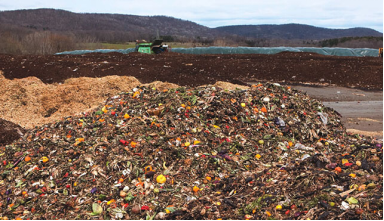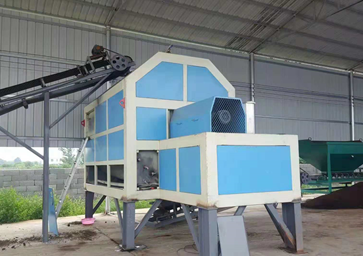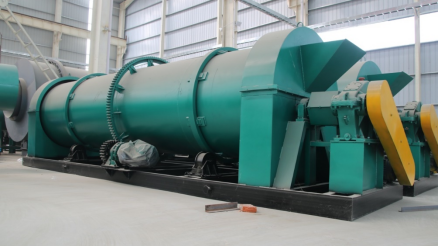Food waste has been increasing as the world’s population has grown and cities have grown in size. Millions of tons of food are thrown into the garbage around the world every year. Nearly 30% of the world’s fruits, vegetables, grains, meats and packaged foods are thrown away each year. Food waste has become a huge environmental problem in every country. Large amounts of food waste cause serious pollution, which damages air, water, soil and biodiversity. On the one hand, food waste breaks down anaerobicly to produce greenhouse gases such as methane, carbon dioxide and other harmful emissions. Food waste produces the equivalent of 3.3 billion tons of greenhouse gases. Food waste, on the other hand, is thrown into landfills that take up large tracts of land, producing landfill gas and floating dust. If the leachate produced during landfill is not handled properly, it will cause secondary pollution, soil pollution and groundwater pollution.
Incineration and landfill have significant disadvantages, and further use of food waste will contribute to environmental protection and increase the utilization of renewable resources.
How food waste is produced into organic fertilizer.
Fruits, vegetables, dairy products, cereals, bread, coffee grounds, eggshells, meat and newspapers can all be composted. Food waste is a unique composting agent that is a major source of organic matter. Food waste includes various chemical elements, such as starch, cellulose, protein lipids and inorganic salts, and N, P, K, Ca, Mg, Fe, K some trace elements. Food waste has a good biodegradable, which can reach 85%. It has the characteristics of high organic content, high moisture and abundant nutrients, and has high recycling value. Because food waste has the characteristics of high moisture content and physical low density structure, it is important to mix fresh food waste with bulking agent, which absorbs excess moisture and adds structure to mix.
Food waste has high levels of organic matter, with crude protein accounting for 15% – 23%, fat for 17% – 24%, minerals for 3% – 5%, Ca for 54%, sodium chloride for 3% – 4%, etc.
Process technology and related equipment for the conversion of food waste into organic fertilizer.
It is well known that the low utilization rate of landfill resources causes pollution to the environment. At present, some developed countries have established a sound food waste treatment system. In Germany, for example, food waste is treated mainly through composting and anaerobic fermentation, producing about 5 million tons of organic fertilizer from food waste each year. By composting food waste in the UK, about 20 million tonnes of CO2 emissions can be reduced each year. Composting is used in almost 95% of U.S. cities. Composting can bring a variety of environmental benefits, including reducing water pollution, and the economic benefits are considerable.
♦ Dehydration
Water is the basic component of food waste accounted for 70%-90%, which is the foundation of food waste spoilage. Therefore, dehydration is the most important part in the process of converting food waste into organic fertilizer.
The food waste pre-treatment device is the first step in the treatment of food waste. It mainly includes Dewatering Systemà Feeding Systemà Automatic Sorting Systemà Solid-Liquid separatorà Oil-Water Separatorà In-vessel composter. The basic flow can be divided into the following steps:
1. Food waste must be pre-dehydrated first because it contains too much water.
2. Removal of inorganic waste from food waste, such as metals, wood, plastics, paper, fabrics, etc., through sorting.
3. Food waste is sorted and fed into a screw type solid-liquid separator for crushing, dehydration and degreasing.
4. Squeezed food residues are dried and sterilized at high temperatures to remove excess moisture and various pathogenic microorganisms. The fineness and dryness of the food waste required for compost achieving, and the food waste can be sent into the in-vessel composter directly through belt conveyor.
5. Water removed from food waste is a mixture of oil and water, separated by an oil-water separator. The separated oil is processed deep to obtain biodiesel or industrial oil.
The whole food waste disposal plant has the advantages of high output, safe operation, low cost and short production cycle.
♦ Compost
Fermentation tank is a kind of fully enclosed tank using high temperature aerobic fermentation technology, which replaces the traditional stacking composting technology. The closed high temperature and fast composting process in the tank produces high-quality compost, which can be controlled more precisely and more stable.
In-vessel composting is insulated, and temperature control is the key factor during composting. A fast breakdown of easily degradable organic matter is achieved by maintaining optimum temperature conditions for the micro-organisms. Achieving a high temperature for inactivating micro-organisms and weed seeds is necessary. The fermentation is a kick-started by naturally occurring micro-organisms in the food waste, they break down the compost materials, releasing the nutrients, increasing the temperature to the 60-70°C needed to kill pathogens and weed seeds, and meet the regulations for processing organic waste. In-vessel composting has the fastest decomposition time, which can compost food waste in as little as 4 days. After just 4-7 days, the compost is discharged, which is odorless, sanitized, and rich in organic material, and has balanced nutrient value.
This odorless, aseptic organic fertilizer produced by composter not only save the filling land to protect the environment, but also will bring some economic benefits.
♦ Granulation
Granular organic fertilizers play an important role in fertilizer supply strategies world side. The key to improving the yield organic fertilizer is to choose suitable organic fertilizer granulation machine. Granulation is the process of material forming into small particles, it enhances material’s technological properties, prevent caking and increase flow properties, make possible the application of small amounts, facilitates loading, transportation, etc. All the raw materials can be made into rounded organic fertilizer through our organic fertilizer granulation machine. The materials granulation rate can reach 100%, and the organic content can be high to 100%.
For Large scale farming, particle size suitable for the use of the market is essential. Our machine can produce organic fertilizers with different size, such as 0.5mm-1.3mm, 1.3mm-3mm, 2mm-5mm. Granulation of organic fertilizer provides some of the most viable ways to blend minerals to create a multi-nutrient fertilizer, allow for bulk storage and packaging, as well as provide ease of handling and application. Granular organic fertilizers are more convenient to use, they are free from unpleasant odors, weed seeds, and pathogens, and their composition is well known. In comparison with animal manure, they contain 4.3 times more nitrogen (N), 4 times phosphorous (P2O5) and as many as 8.2 times more potassium (K2O). Granular fertilizer improves the soil viability by increasing humus levels, many soil productivity indicators are improved: physical, chemical, microbiological soil properties and humidity, air, heat regime, and also crop yields.
♦ Dry and cool.
Rotary drum drying & cooling machine are often used together during organic fertilizer production line. The water content of organic fertilizer is removed, the temperature of granules is reduced, achieving the purpose of sterilization and deodorization. The two steps can minimize the loss of nutrients in granules and improved particle strength.
♦ Sieve and package.
The screening process is to separate those unqualified granular fertilizers that is completed by the rotary drum screening machine. The unqualified granular fertilizers are sent to be processed again, meanwhile the qualified organic fertilizer will be packaged by automatic packaging machine.
Benefit from food waste organic fertilizer
Converting food waste into organic fertilizers can create economic and environmental benefits that can improve soil health and help reduce erosion and improve water quality. Renewable natural gas and biofuels can also be produced from recycled food waste, which can help reduce greenhouse gas emissions and dependence on fossil fuels.
Organic fertilizer is the best nutrient for soil. It is a good source of plant nutrition, including nitrogen, phosphorus, potassium and micronutrients, which are necessary for plant growth. It can not only reduce some plant pests and diseases, but also reduce the need for a variety of fungicides and chemicals. High-quality organic fertilizers will be used in a wide range of fields, including agriculture, local farms and in floral displays in public spaces, which will also bring direct economic benefits to producers.
Post time: Jun-18-2021




